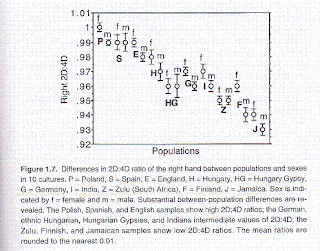Sunday, April 18, 2010
Digit ratios among ten populations
As I described before, the ratio of the length of the index finger to the ring finger is thought to measure the balance of estrogen and testosterone an embryo/fetus is exposed to. Shorter relative index finger length indicates masculinization. The graph above is from page 19 in John Manning's Digit Ratio: A Pointer to Fertility, Behavior, and Health (2002, Rutgers University Press). It shows the means for males and females from ten different populations. The graph does not show the results for Lithuanians and Latvians who scored in the mid-90s. (They were not included since subjects' hands were measured differently).
The trend looks curvilinear with "masculine" populations nearer to the equator or at high latitudes (Finns). The two black populations are masculine. Notice how the population differences are much larger than the sex differences. Jamaican women have more masculine ratios than most of the male European populations.
Subscribe to:
Post Comments (Atom)
Are gun owners mentally ill?
Some anti-gun people think owning a gun is a sign of some kind of mental abnormality. According to General Social Survey data, gun owners ...

-
Which factor reduces family size the most? Below are the standardized OLS regression coefficients for a sample of whites ages 40-59: Stand...
-
In the comments in the last post , some readers contended that Jews are not ethnocentric. Using the same question I used in the comments se...
-
I've been distributing a questionnaire to students which, among other things, asks them their religion. Quite a few have answered "...


The trend isn't really curvilinear, the Finno-Baltic area has just undergone some sort of unique selection pressure for masculinization. E.g. the area has the highest semen quality in Europe.
ReplyDeleteBut Norway and Denmark are extremely feminine, and even within Finland, feminization increases with latitude.
On the other hand, if you follow digit ratio stuff, East Asians don't end up anywhere near where you would predict. The Chinese consistently show hyper-masculine digit ratios.
This comment has been removed by the author.
ReplyDeleteRecently-published findings "call into question the validity of 2D:4D as a simplistic retrospective biomarker for prenatal testosterone exposure."
ReplyDelete